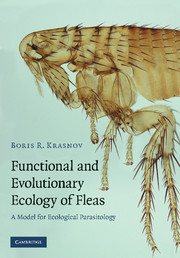Book contents
- Frontmatter
- Contents
- Preface
- Part I Brief descriptive ecology: what do fleas do?
- Part II Functional ecology: how do fleas do what they do?
- 7 Ecology of sexual dimorphism, gender differences and sex ratio
- 8 Ecology of flea locomotion
- 9 Ecology of host selection
- 10 Ecology of haematophagy
- 11 Ecology of reproduction and pre-imaginal development
- 12 Ecology of flea virulence
- 13 Ecology of host defence
- Part III Evolutionary ecology: why do fleas do what they do?
- References
- Index
11 - Ecology of reproduction and pre-imaginal development
Published online by Cambridge University Press: 14 August 2009
- Frontmatter
- Contents
- Preface
- Part I Brief descriptive ecology: what do fleas do?
- Part II Functional ecology: how do fleas do what they do?
- 7 Ecology of sexual dimorphism, gender differences and sex ratio
- 8 Ecology of flea locomotion
- 9 Ecology of host selection
- 10 Ecology of haematophagy
- 11 Ecology of reproduction and pre-imaginal development
- 12 Ecology of flea virulence
- 13 Ecology of host defence
- Part III Evolutionary ecology: why do fleas do what they do?
- References
- Index
Summary
The main evolutionary motivation of every species is to increase its reproductive success, a goal that is achieved via various adaptations to specific ecological conditions, biotic and abiotic. Consequently, investigating reproductive patterns in different situations and disentangling factors that affect reproduction traits is an integral part of any ecological and evolutionary study. We already know that a flea life cycle is typical for a holometabolous insect. Consequently, individuals at different stages of this cycle have neither the same requirements nor the same possibilities and constraints. Furthermore, the effect of an abiotic (e.g. ambient temperature) or biotic (e.g. host identity) factor on flea individuals belonging to one stage of the cycle may be transformed or compensated by the effect of the same or another factor on individuals belonging to another stage of the cycle. Therefore, flea reproductive success should be measured both at each stage of the life cycle and over the entire cycle. This chapter discusses how various factors affect flea reproductive success. I start with issues related to measurement of reproductive outcome considering both quantity and quality of offspring. Then, the effect of both biotic (hosts and other fleas) and abiotic (external environment) interactions will be discussed.
Measures of reproductive success
At first glance, measuring reproductive success seems quite straightforward. Indeed, the number of offspring per female may represent the simplest measure. However, several caveats should be mentioned. The first is related to the time period for which offspring production should be considered.
- Type
- Chapter
- Information
- Functional and Evolutionary Ecology of FleasA Model for Ecological Parasitology, pp. 182 - 216Publisher: Cambridge University PressPrint publication year: 2008



